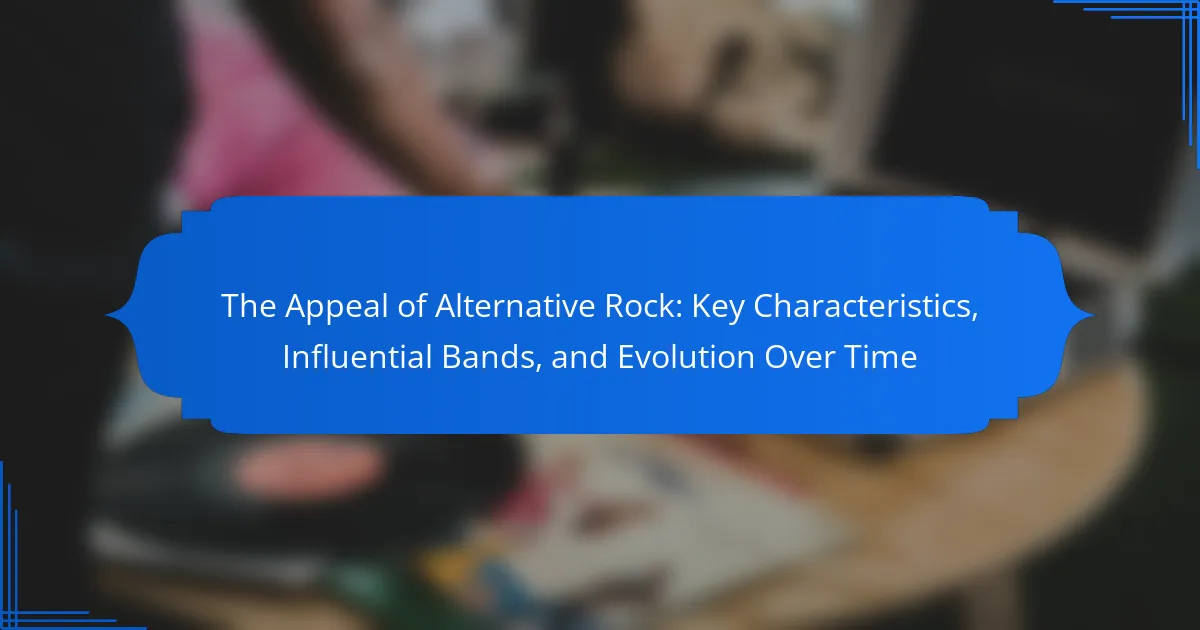Alternative rock is a musical genre characterized by its unique sound and cultural significance, blending elements from punk, post-punk, and new wave. Emerging in the 1980s and achieving mainstream success in the 1990s, it features introspective lyrics and emotional depth, appealing to a diverse audience. Influential bands such as Nirvana, Radiohead, and R.E.M. have shaped the genre, with notable albums like “Nevermind” and “OK Computer” marking pivotal moments in its evolution. Over the decades, alternative rock has diversified, incorporating various styles and influences while challenging mainstream music norms, ensuring its ongoing relevance in contemporary music culture.

What defines the appeal of alternative rock?
The appeal of alternative rock is defined by its distinct sound and cultural relevance. This genre blends various musical styles, including punk, post-punk, and new wave. Alternative rock often features introspective lyrics that resonate with a diverse audience. The genre emerged prominently in the 1980s and gained mainstream popularity in the 1990s. Bands like Nirvana and Radiohead played pivotal roles in shaping its identity. The raw authenticity and emotional depth of alternative rock attract listeners seeking genuine expression. Additionally, its subversive nature challenges mainstream music norms, appealing to those who value individuality. The genre’s evolution continues to influence contemporary music, reflecting changing societal themes.
How did alternative rock emerge as a genre?
Alternative rock emerged as a genre in the 1980s as a response to mainstream rock music. It was characterized by a diverse sound that incorporated elements from punk, post-punk, and new wave. Bands like R.E.M. and The Smiths played pivotal roles in defining the genre’s early sound. The term “alternative” was used to describe music that was outside the traditional rock and pop mainstream. The genre gained significant popularity in the 1990s with the success of bands like Nirvana and Pearl Jam. This period marked the rise of grunge and a broader acceptance of alternative rock in popular culture. The genre’s emergence was also fueled by the rise of independent record labels and college radio stations. These platforms provided a space for alternative artists to reach audiences without the constraints of major labels.
What cultural and musical influences shaped alternative rock?
Alternative rock was shaped by a variety of cultural and musical influences. The punk rock movement of the 1970s laid the groundwork for its rebellious spirit. Bands like The Ramones and [censured] Pistols exemplified a DIY ethic that resonated with alternative rock artists. Additionally, the post-punk genre introduced experimental sounds and themes, influencing bands like Joy Division and The Cure.
The grunge movement of the early 1990s, led by bands such as Nirvana and Pearl Jam, brought alternative rock into mainstream consciousness. This era was marked by a fusion of punk, heavy metal, and indie rock elements. Furthermore, the influence of college rock in the 1980s provided a platform for bands like R.E.M. and The Pixies, who emphasized lyrical depth and sonic experimentation.
Cultural movements such as feminism and anti-establishment sentiments also played significant roles. These movements encouraged artists to express personal and political themes in their music. The rise of independent record labels further facilitated the growth of alternative rock, allowing diverse voices to emerge.
In summary, alternative rock was shaped by punk, post-punk, grunge, college rock, and various cultural movements, all contributing to its unique sound and ethos.
What role did the underground music scene play in its development?
The underground music scene significantly influenced the development of alternative rock. It provided a platform for experimentation and innovation outside mainstream commercial constraints. This environment fostered diverse sounds and styles that shaped the genre. Bands like Sonic Youth and R.E.M. emerged from this scene, gaining traction through grassroots efforts. The underground scene also emphasized DIY ethics, encouraging artists to self-produce and distribute their music. This approach led to a unique authenticity that resonated with audiences. Additionally, underground venues became crucial spaces for live performances, promoting local talent. Overall, the underground music scene was essential in cultivating the alternative rock movement.
What are the key characteristics of alternative rock?
Alternative rock is characterized by its diverse sound and unconventional approach. It often incorporates elements from various genres, including punk, post-punk, and indie music. Lyrically, alternative rock tends to explore themes of angst, disillusionment, and social issues. The instrumentation frequently features a mix of electric and acoustic guitars, bass, and drums. Vocals in alternative rock can range from melodic to raw and emotive. Bands in this genre typically prioritize artistic expression over commercial appeal. Notable examples include Radiohead, Nirvana, and R.E.M., which have significantly influenced the genre’s evolution. The genre emerged in the 1980s and gained mainstream popularity in the 1990s, marking a shift in popular music.
How do lyrical themes differentiate alternative rock from mainstream genres?
Lyrical themes in alternative rock often focus on introspection, existentialism, and social critique, setting them apart from mainstream genres. Mainstream genres typically emphasize themes of love, partying, and commercial success. Alternative rock lyrics often explore personal struggles, mental health, and societal issues, reflecting a more authentic and raw emotional experience. For instance, bands like Radiohead and Nirvana address themes of alienation and disillusionment. This thematic depth resonates with listeners seeking authenticity, contrasting with the often formulaic nature of mainstream music. The distinct focus on complex emotions and social commentary in alternative rock creates a unique identity within the broader music landscape.
What musical elements are commonly found in alternative rock songs?
Alternative rock songs commonly feature distorted guitars, unconventional song structures, and introspective lyrics. Distorted guitars create a raw and edgy sound. Unconventional song structures often eschew traditional verse-chorus formats. Introspective lyrics provide depth and emotional resonance. Additionally, alternative rock incorporates diverse influences from punk, grunge, and indie music. This genre often includes dynamic shifts in tempo and volume. Instruments like synthesizers and keyboards may also be used. The incorporation of these elements contributes to the genre’s distinct identity.
Why do listeners gravitate towards alternative rock?
Listeners gravitate towards alternative rock due to its unique sound and emotional depth. This genre often combines elements from various musical styles, creating a diverse listening experience. Alternative rock frequently features introspective lyrics that resonate with personal experiences. Many listeners appreciate the authenticity and rawness in the music and performances. Bands like Nirvana and Radiohead have significantly influenced the genre’s appeal. Their innovative approaches have attracted a loyal fan base. According to a study by the Pew Research Center, 47% of young adults enjoy alternative rock for its relatability and originality. This connection to personal and societal themes enhances its popularity among listeners.
What emotional connections do fans experience with alternative rock music?
Fans experience deep emotional connections with alternative rock music through themes of authenticity and personal expression. The genre often addresses feelings of angst, isolation, and rebellion. Lyrics frequently resonate with listeners’ personal struggles and experiences. This connection fosters a sense of community among fans who share similar emotions. Research indicates that music can evoke strong emotional responses, enhancing connections to personal identity. Alternative rock’s raw sound and lyrical depth contribute to its appeal. Historical context shows that bands like Nirvana and Radiohead shaped these emotional connections through their impactful music. The genre’s ability to articulate complex feelings makes it a powerful outlet for fans.
How does alternative rock reflect societal issues and personal experiences?
Alternative rock reflects societal issues and personal experiences through its lyrics and themes. The genre often addresses topics such as political unrest, mental health, and social alienation. Bands like Nirvana and Radiohead have tackled issues like depression and existential angst in their music. Their songs resonate with listeners facing similar struggles. This connection fosters a sense of community among fans. Additionally, alternative rock often critiques mainstream culture and consumerism. The raw and authentic sound of the genre enhances its emotional impact. The genre’s evolution showcases changing societal norms and personal narratives over time.

Which bands have been most influential in alternative rock?
Nirvana, Radiohead, and R.E.M. are among the most influential bands in alternative rock. Nirvana’s album “Nevermind” revolutionized the genre in the early 1990s. Their sound and themes resonated with a generation. Radiohead’s experimentation with sound and structure has pushed boundaries since the 1990s. Their album “OK Computer” is often cited as a landmark in alternative music. R.E.M. helped define the genre in the 1980s with their jangly guitars and introspective lyrics. Their influence can be seen in countless bands that followed. These bands shaped the landscape of alternative rock significantly. Their contributions continue to inspire new artists today.
What are the defining characteristics of iconic alternative rock bands?
Iconic alternative rock bands are characterized by their distinctive sound, lyrical depth, and cultural impact. They often blend elements from various genres, such as punk, grunge, and indie rock. This genre typically features unconventional song structures and varied instrumentation. Lyrically, these bands explore themes of angst, social issues, and personal introspection.
The vocal styles can range from melodic singing to raw, emotive expressions. Band dynamics often include a strong sense of individuality and artistic experimentation. Many iconic bands, like Nirvana and Radiohead, have influenced mainstream music and culture significantly. Their work often resonates with listeners, creating a loyal fanbase. The cultural significance of these bands is evident in their lasting legacy and continued relevance in music today.
How did bands like Nirvana and Radiohead shape the genre?
Nirvana and Radiohead significantly shaped the alternative rock genre. Nirvana popularized grunge in the early 1990s. Their album “Nevermind” sold over 30 million copies worldwide. This success brought alternative rock into mainstream music. Nirvana’s raw sound and honest lyrics influenced countless bands.
Radiohead, emerging in the mid-1990s, expanded alternative rock’s sonic possibilities. Their album “OK Computer” introduced complex themes and experimental sounds. This work is often cited as a landmark in the genre. Radiohead’s willingness to innovate inspired many artists to explore new directions.
Together, these bands redefined what alternative rock could be. They pushed boundaries and challenged conventions in music. Their legacies continue to influence contemporary artists today.
What contributions did lesser-known bands make to the alternative rock scene?
Lesser-known bands significantly contributed to the alternative rock scene by introducing diverse sounds and perspectives. These bands often experimented with genre-blending, incorporating elements from punk, folk, and electronic music. Their unique styles helped to expand the boundaries of alternative rock. For example, bands like The Pixies influenced mainstream acts with their dynamic shifts in sound. Additionally, lesser-known bands often tackled unconventional themes in their lyrics, addressing social issues and personal struggles. This lyrical depth resonated with audiences seeking authenticity. The underground scene provided a platform for these bands, fostering a community that valued artistic expression. Their contributions enriched the genre and inspired future artists.
How have these bands influenced modern artists?
Influential bands in alternative rock have significantly shaped modern artists’ music styles and approaches. Bands like Nirvana and Radiohead introduced raw emotional expression and innovative soundscapes. Their influence can be seen in the music of contemporary artists like Billie Eilish and Hozier. Nirvana’s grunge aesthetic inspired a wave of artists to embrace authenticity and vulnerability in their lyrics. Radiohead’s experimental techniques encouraged modern musicians to explore genre-blending and unconventional song structures. Additionally, the DIY ethos of bands like Sonic Youth has motivated many indie artists to self-produce their work. This legacy of pushing creative boundaries continues to resonate in today’s music scene.
What common traits do contemporary alternative rock bands share with their predecessors?
Contemporary alternative rock bands share several common traits with their predecessors. Both groups often emphasize emotional expression in their lyrics. This focus on personal and societal themes resonates with audiences. Additionally, they frequently incorporate diverse musical influences, blending genres like punk, folk, and electronic.
Instrumentation remains similar, with guitars, bass, and drums being foundational elements. Both eras also prioritize authenticity and a DIY ethos. This approach fosters a connection with fans who value sincerity. Furthermore, contemporary bands often cite earlier artists as major influences in their work. This lineage reinforces the genre’s evolution while maintaining its core identity.
How does the legacy of classic alternative bands continue to impact new music?
The legacy of classic alternative bands significantly influences new music. Their innovative sound and lyrical depth set a standard for authenticity. Bands like Nirvana and Radiohead pioneered genres that continue to inspire modern artists. Their use of unconventional song structures encourages experimentation in contemporary music. Classic alternative bands also addressed social issues, shaping the thematic content of new songs. This influence is evident in the work of current artists like Billie Eilish and Tame Impala. They incorporate elements from the past while adding their unique touch. The enduring popularity of classic alternative music solidifies its impact on today’s music landscape.

How has alternative rock evolved over time?
Alternative rock has evolved significantly since its inception in the 1980s. Initially, it emerged as a response to mainstream rock and pop music. Bands like R.E.M. and The Smiths defined the genre’s early sound with jangly guitars and introspective lyrics. In the 1990s, alternative rock gained mainstream popularity through the grunge movement, led by bands like Nirvana and Pearl Jam. This era introduced heavier guitar riffs and darker themes. The 2000s saw a diversification of styles within alternative rock. Bands like The Strokes and Arctic Monkeys brought a garage rock revival. Meanwhile, electronic influences began to appear with groups like Radiohead experimenting with sound. Today, alternative rock continues to blend genres, incorporating elements from hip-hop, pop, and electronic music. This ongoing evolution reflects the genre’s adaptability and relevance in contemporary music culture.
What major trends have shaped the evolution of alternative rock?
Alternative rock has evolved through several major trends. The rise of grunge in the early 1990s brought bands like Nirvana and Pearl Jam to prominence. This genre emphasized raw sound and introspective lyrics. The 2000s saw the emergence of pop-punk, led by bands such as Blink-182 and Green Day. This trend focused on catchy melodies and youthful themes. The integration of electronic elements in the late 2000s and 2010s introduced artists like Radiohead and The xx. This shift blended rock with synth and experimental sounds. Additionally, the DIY ethic from independent labels has influenced many artists’ approaches. This trend has encouraged authenticity and personal expression in alternative rock. Overall, these trends have collectively shaped the diverse landscape of alternative rock music.
How did the rise of technology influence the production and distribution of alternative rock?
The rise of technology significantly transformed the production and distribution of alternative rock. Digital recording tools allowed artists to produce high-quality music at lower costs. This democratized music production, enabling independent bands to create and release their work without major label support. The internet facilitated the widespread distribution of music. Platforms like Bandcamp and SoundCloud allowed artists to share their music globally. Social media connected bands directly with fans, fostering grassroots marketing. Streaming services changed how listeners access and consume music, prioritizing singles over albums. Overall, technology reshaped both the creative process and the industry’s economic landscape.
What role has streaming played in the genre’s transformation?
Streaming has significantly transformed the alternative rock genre by increasing accessibility and exposure. Platforms like Spotify and Apple Music allow listeners to discover new bands and songs easily. This accessibility has led to a broader audience for alternative rock. As a result, artists can reach fans without traditional record label support. Streaming has also influenced music production and distribution strategies. Artists often release singles or EPs to maintain listener engagement. Data from platforms provides insights into listener preferences, shaping future music trends. Overall, streaming has democratized the music landscape for alternative rock artists and fans alike.
What future directions might alternative rock take?
Alternative rock may evolve by incorporating more electronic elements. Many bands are already experimenting with synths and digital production. This trend reflects the broader music industry’s shift toward electronic sounds. Collaborations with electronic artists are becoming more common. Artists like Radiohead and Nine Inch Nails have already paved the way. The genre may also see a return to its roots with grunge influences. Nostalgia for 90s alternative rock is evident in current music trends. Additionally, alternative rock may increasingly address social and political issues. Bands are using their platforms to comment on contemporary events. This thematic evolution resonates with younger audiences. Overall, alternative rock’s future appears to be a blend of innovation and tradition.
How are emerging artists redefining the sound of alternative rock?
Emerging artists are redefining the sound of alternative rock by blending genres and experimenting with innovative production techniques. They incorporate elements from electronic music, hip-hop, and pop, creating hybrid sounds. This genre fusion attracts a broader audience and challenges traditional rock norms. For instance, artists like Billie Eilish and Tame Impala utilize unique soundscapes and introspective lyrics. Their work showcases a departure from conventional guitar-driven melodies. Additionally, the rise of digital platforms allows for diverse influences to shape their music. This accessibility enables artists to collaborate across genres effortlessly. The result is a fresh, dynamic interpretation of alternative rock that resonates with contemporary listeners.
What potential influences could shape the next wave of alternative rock music?
Emerging technologies and digital platforms will significantly influence the next wave of alternative rock music. Streaming services allow for greater accessibility to diverse genres and artists. This accessibility encourages genre-blending and experimentation. Social media platforms facilitate direct artist-fan interactions. Artists can share their creative processes and receive immediate feedback. Cultural shifts, such as increased awareness of social issues, inspire lyrical content. Collaborations across genres are becoming more common. Influences from global music scenes are likely to shape alternative rock’s sound. The resurgence of vinyl and physical media reflects a desire for authenticity in music consumption.
What are some tips for discovering new alternative rock music?
Explore music streaming platforms for curated playlists. Services like Spotify and Apple Music feature alternative rock playlists. Follow music blogs and websites dedicated to alternative rock. These sources often highlight emerging artists and albums. Attend local concerts and music festivals to experience new bands live. Engaging with the local music scene can introduce you to fresh sounds. Utilize social media to connect with artists and fans. Platforms like Instagram and Twitter often showcase new music releases. Join online communities or forums focused on alternative rock. These spaces facilitate discussions about lesser-known bands and tracks.
The main entity of this article is alternative rock, a genre characterized by its distinct sound, cultural relevance, and introspective lyrics. The article explores the emergence of alternative rock in the 1980s, its key characteristics, and the influential bands that shaped its identity, including Nirvana and Radiohead. It examines the cultural and musical influences that contributed to the genre’s development, the role of the underground music scene, and the emotional connections fans have with the music. Additionally, the article discusses the evolution of alternative rock over time, major trends that have shaped the genre, and the impact of technology and streaming on its transformation.
